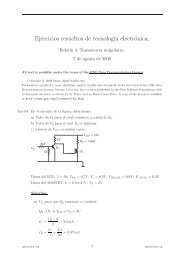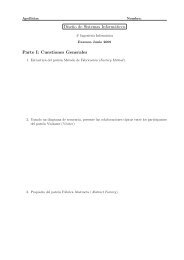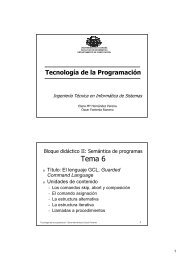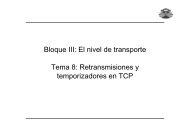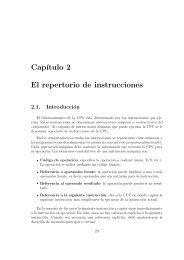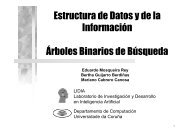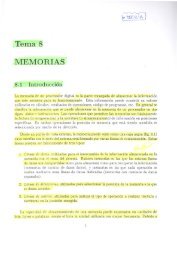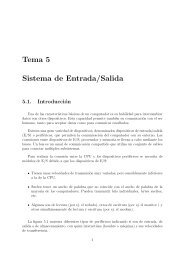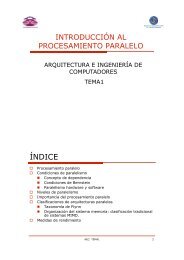repaso de fundamentos matemáticos - QueGrande
repaso de fundamentos matemáticos - QueGrande
repaso de fundamentos matemáticos - QueGrande
You also want an ePaper? Increase the reach of your titles
YUMPU automatically turns print PDFs into web optimized ePapers that Google loves.
PÁG. 16 DE 24 TEMA 0: REPASO FUNDAMENTOS MATEMÁTICOS<br />
0.2.7. DERIVADA PARCIAL (DERIVADA APLICADA A FUNCIONES MULTIVARIABLES)<br />
Si consi<strong>de</strong>ramos una función <strong>de</strong> muchas variables (PREGUNTA: ¿qué era una función multivariable, si<br />
no lo recuerdas, repasa el tema 0.2.5 en la página 9), entonces se pue<strong>de</strong> <strong>de</strong>rivar respecto <strong>de</strong> cada una <strong>de</strong><br />
ellas.<br />
Q) ¿Qué es una <strong>de</strong>rivada parcial Es una generalización <strong>de</strong> la <strong>de</strong>rivada absoluta: es el cociente entre<br />
el cambio <strong>de</strong>l valor <strong>de</strong> la función respecto <strong>de</strong>l cambio <strong>de</strong> una <strong>de</strong> sus variables, consi<strong>de</strong>rando las otras<br />
variables como constantes.<br />
C) ¿Cómo se representa matemáticamente la i<strong>de</strong>a <strong>de</strong> <strong>de</strong>rivada parcial<br />
Tienes una función w que <strong>de</strong>pen<strong>de</strong> <strong>de</strong> tres variables x, y, z; es <strong>de</strong>cir w=w(x,y,z) (observa esta<br />
notación: hemos simplificado un poco utilizando la misma letra: w a la izquierda y w a la <strong>de</strong>recha, en lugar<br />
<strong>de</strong> w=g(x,y,z), por ejemplo). La <strong>de</strong>rivada parcial <strong>de</strong> w respecto <strong>de</strong> x se representa y <strong>de</strong>fine así:<br />
Cambio<br />
678<br />
en x<br />
w w( x +Dx , yz , )-wxyz<br />
( , , )<br />
= lim<br />
x D x®<br />
0<br />
Dx<br />
(T0. 29)<br />
es <strong>de</strong>cir: partimos <strong>de</strong>l valor <strong>de</strong> la función w en (x,y,z), y luego <strong>de</strong>splazamos x a x+Dx, sin cambiar y ni z, y<br />
comparamos los cambios <strong>de</strong> w y <strong>de</strong> x. Luego hacemos Dx muy pequeña.<br />
Las <strong>de</strong>rivadas parciales respecto <strong>de</strong> las otras dos variables se <strong>de</strong>finen <strong>de</strong> modo análogo:<br />
w wxy ( , +Dyz , )-wxyz<br />
( , , )<br />
= lim<br />
y<br />
y<br />
D y ® 0<br />
D<br />
w wxyz ( , , +Dz) -wxyz<br />
( , , )<br />
= lim<br />
z D z ® 0<br />
Dz<br />
(T0. 30)<br />
(T0. 31)<br />
Observa: sólo hemos consi<strong>de</strong>rado el cambio en y en (T0. 30), y el cambio en z en (T0. 31).<br />
¿Cómo se calcula una <strong>de</strong>rivada parcial Como si fuese una <strong>de</strong>rivada absoluta respecto <strong>de</strong> una <strong>de</strong> sus<br />
variables, manipulando las otras como si fuesen provisionalmente constantes.<br />
EJEMPLO 0. 26: Si tienes w=2.x 2 .y+4.z 3 −3.z.ln(y), <strong>de</strong>rivas con respecto a x, consi<strong>de</strong>rando y y z<br />
constantes:<br />
}<br />
}<br />
const.<br />
const.<br />
const.<br />
64748<br />
2 3 3<br />
w ( 2xy + 4z - 3zlny)<br />
(2 yx ( )<br />
2 ) 4z ( 3zlny)<br />
= = + - =<br />
x x x x x<br />
2<br />
( x )<br />
w<br />
= 2y + 0- 0 = 2 y(2 x) = 4xy Þ = 4xy<br />
x<br />
x<br />
(T0. 32)<br />
Derivas parcialmente respecto <strong>de</strong> y, esta vez “aislando” x y z:<br />
} }<br />
const.<br />
const.<br />
const.<br />
2 3 }<br />
( + - 2<br />
) (<br />
3<br />
w 2xy 4z 3zlny (2 x y) 4z<br />
) (3z ln y)<br />
= = + - =<br />
y y y y y<br />
( )<br />
y<br />
2 (ln y) 2 æ 1ö<br />
w 2 3z<br />
= 2x + 0- 3z = 2x -3zç ÷ Þ = 2x<br />
-<br />
y y èy ø y y<br />
(T0. 33)<br />
J. BRÉGAINS APUNTES COMPLEMENTARIOS DE FMC






